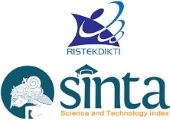KOLABORASI KREATIF KEGIATAN PARIWISATA DAN PELESTARIAN BUDAYA DI TAMAN BUDAYA YOGYAKARTA (TBY)
Abstract
ABSTRACT
Sebagai kota budaya, kota seni, kota pendidikan, dan kota pariwisata, Yogyakarta berpotensi untuk berkembang sebagai kota kreatif. Saat ini, konsep kota kreatif banyak digunakan sebagai konsep perencanaan untuk menyelesaiakan isu sosial budaya dan ekonomi di perkotaan untuk mendukung pembangunan berkelanjutan. Aktifitas interaksi di dalam maupun antar komunitas merupakan nyawa yang menjadi motor penggerak kehidupan bagi kota kreatif. Berbagai studi menunjukkan bahwa ruang interaksi berperan penting dalam terlaksananya kegiatan kreatif pada wisata perkotaan, interaksi dapat menghasilkan gagasan atau metode baru dari yang terdahulu ada. Taman Budaya Yogyakarta (TBY) merupakan salah satu fasilitas ruang interaksi publik milik pemerintah di Kota Yogyakarta yang banyak digunakan untuk penyelenggaraan acara seni dan budaya. Penelitian ini bertujuan untuk memahami pola kolaborasi kreatif dari kegiatan pariwisata dan pelestarian budaya di TBY. Dengan menggunakan metode induktif dan data kualitatif yang didapatkan dari observasi lapangan, dan wawancara, setiap aspek aktivitas di TBY akan dianalisis mengenai bentuk-bentuk kolaborasi kreatif, aktor, dan pola kolaborasi kreatif. Hasil menunjukkan bahwa kolaborasi kreatif muncul dari aspek nilai-nilai kegiatan, bentuk kegiatan, manajemen kegiatan, serta peranan pemangku kepentingan. Terwujudnya kolaborasi kreatif didukung oleh komunitas sebagai aktor penggerak dominan penyelenggaraan acara di TBY. Peran TBY sebagai daya tarik wisata sekaligus sarana pelestarian budaya juga disadari oleh pemerintah dan pengelola yang kemudian mengatur pergerakan kegiatan melalui kebijakan dan peraturan. Selain itu, motivasi dan persepsi masyarakat terhadap pariwisata budaya yang berkembang seiring pesatnya informasi juga mempengaruhi terwujudnya kolaborasi kreatif pariwisata dan pelestarian budaya di TBY.
Kata Kunci: Kolaborasi Kreatif, Konservasi Budaya, Taman Budaya Yogyakarta
CREATIVE COLLABORATION OF TOURISM ACTIVITIES AND CULTURE PRESERVATION IN TAMAN BUDAYA YOGYAKARTA (TBY)
ABSTRACT
Yogyakarta has potential capacity in developing it to be a creative city due to its being cultural, art, education, and tourism city. Today, the concept of creative city is often used in planning concepts to offer a way in solving social, cultural, and economic problems in a city whenever it concerns sustainable development and the most important factor in this issue is human beings who inhabit the city. Human beings, the people as a local community, are the
soul that enables the creative city to be alive. Many studies show that interaction space plays an important role in a creative city as it is with this interaction that creative activities take place, and this is significant in developing city tourism. It is with this interaction that new ideas or new methods may appear. It is in this context that this research is conducted. It focuses on how a group of people create a collaborative work in cultural preservation and tourism. This interaction space is called Taman Budaya Yogyakarta (TBY). TBY, or Yogyakarta Culture Space, provides a space for communities to hold art and cultural events. With the objective of mapping the creative collaboration facilitated by TBY in the effort to preserve the culture, this research finds out the creative patterns in each aspect of cultural activities which bears cultural preservation and tourism aspects. The creativity patters appear in activity values, form, management and the role of the stakeholders. The creative collaboration is supported by dominant actors in providing the activities in TBY. TBY is therefore a driving factor in not only cultural preservation but also in tourism. Government role and people’s perception and motivation developing along with the development of information technology also contributes to the success of tourism creative collaboration and cultural preservation in TBY.
Keywords: Creative Collaboration, Culture Preservation, Taman Budaya Yogyakarta
Keywords
Full Text:
PDFReferences
Alwasilah, A. Chaedar. (2006). Pokoknya Kualitatif. Jakarta : Pustaka Jaya
A.S. Dorcheh, B. Mohamed. Local perception of tourism development: A conceptual framework for the sustainable cultural tourism. Journal of Management and Sustainability, 3 (2) (2012), pp. 31-39
MacDonald, C. Understanding participatory action research: A qualitative research methodology option. Canadian Journal of Action Research, 13 (2) (2012), pp. 34-50
Kakiuchi, Emiko. Culturally creative cities in Japan: Reality and prospects. City, Culture and Society, 7 (2) (2016), pp. 101-108, https://doi.org/10.1016/j.ccs.2015.11.003
Kotler, P. and Keller, K. 2012. Marketing management. Upper Saddle River, N.J.: Prentice Hall.
L.R. Allen, P.T. Long, R.R. Perdue, S. Kieselbach. The impact of tourism development on residents’ perceptions of community life. Journal of Travel Research, 27 (1) (1988), pp. 16-21
Macleod, Donald V.L. 2004. Tourism, Globalisation and Cultural Change: an Island Community Perspective. UK: Channel View Publications
Mill, R.C., and Morison, A.M. 1985. The Tourism System. Prentice-Hall International.
Moirano, R, et.al. Creative interdisciplinary collaboration: A systematic literature review. Thinking Skills and Creativity, 35 (2020). https://doi.org/10.1016/j.tsc.2019.100626
Ritzer, George. 2011. Globalization: The Essentials. John Wiley & Sons Ltd.
Rodrigues, M., and Franco, M. Network and Performance of Creative Cities: A bibliometric analysis. City, Culture and Society. 20 (2020), https://doi.org/10.1016/j.css.2019.100326
Rosi, Mauro. Branding or sharing? The dialectics of labeling and cooperation in the UNESCO Creative Cities Network. City, Culture and Society. 5 (2014), pp. 107–110
Sangchumnong, Aunkrisa. Development of a sustainable tourist destination based on the creative economy: A case study of Klong Kone Mangrove Community, Thailand. Kasetsart Journal of Social Sciences (2018), https://doi.org/10.1016/j.kjss.2018.02.002
Sari, Y.K., 2012. Dampak Pembangunan Fasilitas Pariwisata terhadap Identitas Kota Yogyakarta. Laporan Penelitian Fakultas Ilmu Budaya UGM. Tidak diterbitkan.
Sklair, Leslie. 2002. Globalization, Capitalism, and Its Alternatives. UK: Oxford University Press
Sofield, Trevor, et.al. Organic ‘folkloric’ community driven place-making and tourism. Journal of Tourism Management, 61 (2017), pp. 1-22
Ucar, Erdem. Local creative culture and corporate innovation. Journal of Business Research (October) (2018), pp. 60-70
Vivant, Elsa. Creatives in the city: Urban contradictions of the creative city. Journal of City, Culture and Society, 4 (2) (2013), pp. 57-63
Yoeti, Oka. 2008. Perencanaan dan Pengembangan Pariwisata. Pradnya Paramitha. Jakarta, Indonesia.
Laman Referensi
https://en.unesco.org/creative-cities/home
https://tby.jogjaprov.go.id/post/art-for-children.html
https://www.tripadvisor.com/Attraction_Review-g294230-d8519866-Reviews-Cultural_Development_Center_of_Yogyakarta-Yogyakarta_Region_Java.html
DOI: https://doi.org/10.17509/jithor.v3i1.21853
Refbacks
- There are currently no refbacks.

This work is licensed under a Creative Commons Attribution-ShareAlike 4.0 International License.
eISSN : 2654-4687
pISSN : 2654-3893
This work is licensed under Creative Commons Attribution-ShareAlike 4.0 International License














